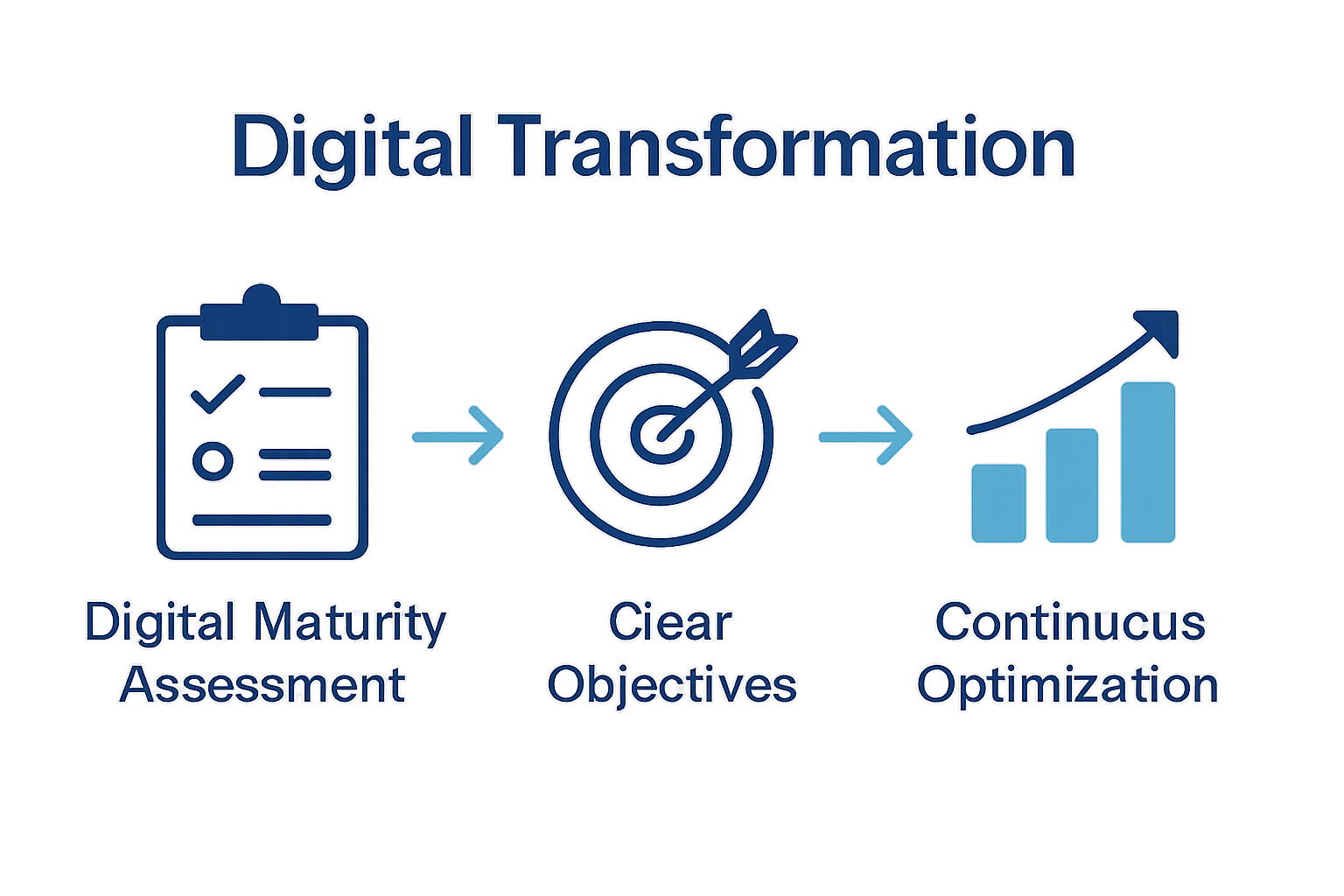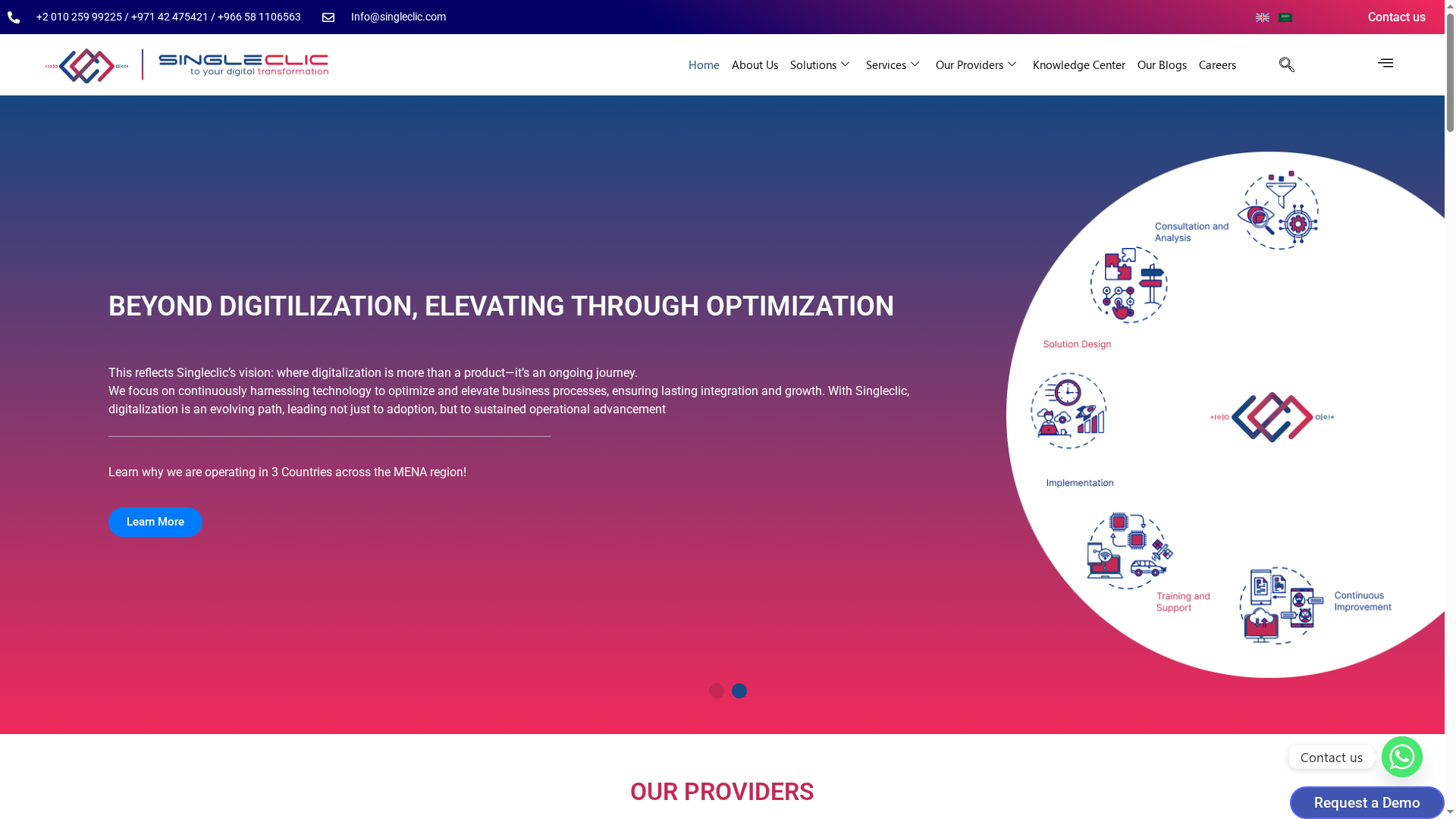More than 80 percent of american businesses say their digital transformation efforts fall short because they misjudge their starting point. Digital change is moving at record speed, especially across regions aiming to match global innovation. Understanding your real strengths and gaps is essential before making major investments that aim to reshape operations or customer experience. This guide offers clear steps to help american organizations confidently evaluate digital maturity and set a focused path for successful transformation.
Table of Contents
- Step 1: Assess Current Digital Maturity
- Step 2: Define Clear Transformation Objectives
- Step 3: Align Leadership and Secure Buy-In
- Step 4: Select and Integrate Key Technologies
- Step 5: Monitor Progress and Optimize Continuously
Quick Summary
| Key Insight | Explanation |
|---|---|
| 1. Assess Digital Maturity First | Start transformation by evaluating your organization’s current digital maturity level to identify strengths and improvement areas. |
| 2. Establish Clear Transformation Goals | Define specific, measurable objectives that align with organizational strategies to guide your digital transformation process. |
| 3. Secure Leadership Alignment | Gain commitment from leadership to create a unified narrative, ensuring all departments understand the transformation’s importance. |
| 4. Choose Appropriate Technologies | Conduct a technology audit to select and integrate systems that align with your transformation goals and regional advantages. |
| 5. Monitor and Optimize Continuously | Implement ongoing performance tracking and establish a culture of optimization to adapt to evolving business landscapes. |

Step 1: Assess Current Digital Maturity
Digital maturity assessment is your strategic starting point for transforming organizational capabilities. According to research from thescipub, understanding your organization’s current digital maturity level is a critical prerequisite for successful digital transformation initiatives.
To conduct a comprehensive digital maturity assessment, begin by gathering cross functional perspectives from your leadership team. This means scheduling individual and group discussions with representatives from IT, operations, finance, human resources, and customer-facing departments. Your goal is to create a holistic view of your current technological capabilities, process efficiencies, and organizational readiness for digital change.
Key assessment areas should include technological infrastructure, data management practices, employee digital skills, customer interaction platforms, and process automation levels. Utilize frameworks like the one developed in journal, which provides a sophisticated model with eight critical factors for evaluating digital service transformation maturity. For organizations in Saudi Arabia and UAE, pay special attention to how your current systems align with regional technological advancement and future strategic goals.
Pro Tip: Our low code platform Cortex can help streamline this assessment by providing real time insights into your current digital ecosystem and potential optimization opportunities. Remember that digital maturity is not a one time evaluation but an ongoing process of continuous improvement and adaptation.

After completing your initial assessment, you will have a clear roadmap of your organization’s digital strengths and improvement areas ready for the next transformation stages.
Step 2: Define Clear Transformation Objectives
Defining precise digital transformation objectives is your strategic blueprint for organizational change. According to research from arxiv, establishing clear transformation objectives is crucial for navigating the complex landscape of technological evolution and strategic adaptation.
Start by conducting a comprehensive stakeholder workshop that brings together leadership from different departments. Your objective is to develop a shared vision that aligns digital transformation goals with broader organizational strategies. Break down your objectives into specific, measurable, achievable, relevant, and time bound targets. These might include improving operational efficiency, enhancing customer experience, developing new digital revenue streams, or modernizing legacy technological infrastructure.
Research from arxiv suggests leveraging frameworks like the business model canvas to map out transformation objectives systematically. For organizations in Saudi Arabia and UAE, consider how these objectives can drive competitive advantage in rapidly digitizing regional markets. Our low code platform Cortex can support this process by providing flexible tools for designing and implementing transformation strategies.
Pro Tip: Ensure your transformation objectives are not just technological upgrades but strategic initiatives that fundamentally reshape how your organization creates and delivers value. Regularly reassess these objectives to maintain alignment with evolving business landscapes and technological capabilities.
Once your objectives are clearly defined, you will be prepared to design a detailed implementation roadmap that transforms your digital transformation vision into actionable strategies.
Step 3: Align Leadership and Secure Buy-In
Securing leadership alignment and organizational commitment is the critical foundation for successful digital transformation. According to research from mdpi, leadership buy-in is essential when implementing advanced technological interventions across complex organizational ecosystems.
Begin by organizing a series of executive workshops designed to build consensus and shared understanding. Your primary goal is to create a unified narrative around digital transformation that resonates with each leadership team member’s strategic priorities. This means translating technical potential into tangible business outcomes that speak directly to each department head’s specific challenges and opportunities. Engage senior executives by presenting concrete scenarios demonstrating how digital transformation can address existing operational bottlenecks, create competitive advantages, and drive sustainable growth.
Research from jmir highlights the importance of developing a comprehensive communication strategy that addresses potential resistance and builds genuine organizational excitement. For organizations in Saudi Arabia and UAE, this means crafting a transformation approach that balances technological innovation with cultural sensitivity and regional business dynamics. Our low code platform Cortex can serve as a powerful visualization tool during these discussions, helping leadership teams understand the practical implementation of digital strategies.
Pro Tip: Create a transformation steering committee with representatives from each department to ensure ongoing alignment and shared accountability. This approach transforms digital transformation from a top-down mandate into a collaborative organizational journey.
Once leadership buy-in is secured, you will be positioned to move forward with detailed implementation planning and resource allocation.
Step 4: Select and Integrate Key Technologies
Selecting and integrating the right technologies is a strategic cornerstone of digital transformation that requires careful planning and assessment. According to research from preprints, developing a robust technology selection model is crucial for enhancing digital transformation capabilities across organizational ecosystems.
Begin by conducting a comprehensive technology audit that maps your current technological infrastructure against your defined transformation objectives. This involves evaluating existing systems, identifying potential integration challenges, and understanding the scalability and compatibility of potential new technologies. Create a detailed matrix that ranks potential technologies based on criteria such as alignment with strategic goals, implementation complexity, cost effectiveness, and potential return on investment. For organizations in Saudi Arabia and UAE, consider technologies that offer regional competitive advantages and align with local digital innovation landscapes.
Research from pmc emphasizes the importance of developing a structured approach to technology selection that goes beyond simple feature comparisons. Our low code platform Cortex can be instrumental in this process, providing flexible integration capabilities and enabling rapid prototyping of technological solutions. Prioritize technologies that offer modular and adaptable architectures, allowing for future expansion and seamless system updates.
Pro Tip: Always conduct pilot tests and create proof of concept implementations before full scale technology integration. This approach allows you to validate technological capabilities and minimize potential implementation risks.
Once you have selected and begun integrating key technologies, you will be ready to develop a comprehensive implementation roadmap that transforms your digital strategy into actionable reality.
Step 5: Monitor Progress and Optimize Continuously
Continuous monitoring and optimization are the lifeblood of successful digital transformation strategies. According to research from thescipub, establishing an iterative roadmap for tracking digital maturity is essential for organizational growth and technological adaptation.
Implement a robust performance measurement framework that goes beyond traditional metrics. Create a comprehensive dashboard that tracks key performance indicators across technological, operational, and strategic dimensions. This means developing a real time monitoring system that captures both quantitative data like system efficiency and qualitative insights such as user adoption rates and employee engagement. For organizations in Saudi Arabia and UAE, customize your monitoring approach to reflect regional technological benchmarks and industry specific transformation goals.
Research from arxiv emphasizes the importance of building a shared understanding through continuous optimization. Our low code platform Cortex can be instrumental in this process by providing flexible analytics and rapid iteration capabilities. Establish a quarterly review cycle where transformation progress is transparently discussed, challenges are identified, and strategic adjustments are made. This approach transforms digital transformation from a linear project into a dynamic, responsive organizational journey.
Pro Tip: Create cross functional optimization teams that combine technical expertise with strategic insights. These teams should have the authority to quickly implement changes and experiment with new approaches.
By maintaining a culture of continuous monitoring and optimization, you will ensure that your digital transformation remains agile, responsive, and aligned with evolving business objectives.
Drive Your Digital Transformation to Success with Singleclic
The article highlights the complex journey of digital transformation from assessing maturity to continuous optimization. Many organizations struggle with aligning leadership, selecting the right technology, and maintaining momentum throughout the process. If you are seeking to overcome these challenges and create a clear, actionable roadmap that guarantees C-level success, Singleclic offers proven solutions tailored for your needs. Our expertise in ERP & CRM Implementation, Business Process Automation, and cutting-edge AI & low-code platforms like Cortex directly addresses pain points such as leadership buy-in, technology integration, and ongoing optimization.
By partnering with Singleclic, a regional leader serving KSA, UAE, and Egypt, you gain access to world-class technology combined with deep industry experience. Cortex, our Arabic-enabled low-code platform mentioned in the article, empowers your teams to design, automate, and evolve complex workflows without coding, fostering continuous improvement and real-time insights. With over 10 years of regional delivery and clients like Dubai Healthcare City and QNB, we bring the agility and support your transformation demands.
Explore how we can help transform your digital vision into reality with solutions that align perfectly with your roadmap. Visit Singleclic to learn more about our comprehensive services and start your journey beyond digitalization.
Unlock your organization’s full potential today.
Looking for a partner to guide and accelerate your digital transformation?

Discover how Singleclic’s expertise in ERP & CRM and low-code platforms can power your C-level digital success. Contact us now at Singleclic and take the first step toward seamless, scalable transformation.
Frequently Asked Questions
How do I assess my organization’s current digital maturity?
To assess your organization’s digital maturity, organize discussions with leaders from various departments like IT, operations, and finance. Collect their insights to create a comprehensive overview of your current technological capabilities and readiness for digital changes.
What steps should I take to define clear digital transformation objectives?
Start by conducting a stakeholder workshop to align digital transformation goals with your organization’s broader strategies. Break these goals down into specific, measurable, achievable, relevant, and time-bound targets that fit your operational needs.
How can I ensure leadership alignment for our digital transformation initiatives?
Create a series of executive workshops aimed at developing a unified narrative around digital transformation. Engage each leader by connecting the transformation goals to their departmental challenges and showing the potential benefits.
What criteria should I use when selecting technologies for digital transformation?
When selecting technologies, create a detailed matrix to evaluate options based on alignment with strategic goals, implementation complexity, cost-effectiveness, and potential ROI. Follow this with a technology audit to review your current infrastructure against your transformation objectives.
How do I monitor progress and optimize my digital transformation efforts?
Implement a robust performance measurement framework that tracks both quantitative and qualitative key performance indicators. Establish a review cycle, such as quarterly, to openly discuss progress, identify challenges, and make necessary adjustments to your transformation strategy.
What are best practices for creating a transformation steering committee?
Form a steering committee that includes representatives from each department to ensure ongoing alignment and shared accountability. This committee should meet regularly to review progress and adapt strategies collectively, transforming digital transformation into a collaborative effort.









